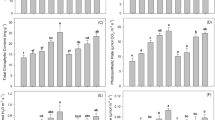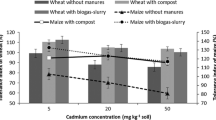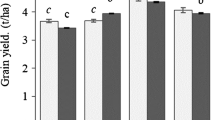Abstract
Crops are constantly faced with the challenges of different abiotic stresses on the field. Development of sustainable approach for stress amelioration on crop is pertinent. This study investigated the ameliorative roles of biochar and compost on maize crop simultaneously subjected to drought and heavy metal (Pb) stresses. Metal stress was imposed by growing maize on Pb-contaminated soil while drought stress was imposed by reducing the soil field capacity to 25 and 50%. Four levels (0, 5, 10 and 15 t/ha) of biochar and compost replicated three times as well as their combinations were used. Pb uptake, translocation factors, photosynthetic pigments, osmolytes (proline and cysteine), biomass accumulation in stressed maize crop, and post-cropping soil Pb concentration were determined. Combination of stresses reduced biomass accumulation in maize. Biochar in combination with compost, however, enhanced biomass production in stressed maize crop by 50–75% compared to unamended soil (control). Proline accumulation was more under the single stress of heavy metal (100% FC) compared to combined stresses. Unlike proline, combined stresses of Pb and 50% FC enhanced chlorophyll and cysteine accumulation more than single stress. Their concentrations were further increased with amendments compared to control. Pb accumulation in maize crop was more under combined stresses than single stress (100% FC). Compared to other soil amendments, application of biochar alone at 10 t/ha, generally reduced Pb uptake by maize and post-cropping soil Pb concentration. Biochar and compost reduced Pb uptake, and enhanced biomass and osmolyte production in stressed maize crop.
















Similar content being viewed by others
References
Adejumo SA, Togun AO, Adediran JA, Ogundiran MB (2010) Effects of compost application on remediation and the growth of maize planted on lead contaminated soil. J Agric Sci Technol A 3:216–225
Adejumo SA, Togun AO, Adediran JA, Ogundiran MB (2011) Field assessment of progressive remediation of soil contaminated with lead-acid battery waste in response to compost application. Pedologist (Special Issue) 54(3):182–193
Adejumo SA, Owolabi MO, Odesola IF (2016) Agro-physiologic effects of compost and biochar produced at different temperatures on growth, photosynthetic pigment and micronutrients uptake of maize crop. Afr J Agric Res 11:661–667
Amlinger F, Peyr S, Geszti J, Dreher P, Karlheinz W, Nortcliff S (2007) Beneficial effects of compost application on fertility and productivity of soils. Literature study, Federal Ministry for Agriculture and Forestry, Environment and Water Management, Austria. https://www.umweltnet.at/filemanager/download/20558/
Arnao MB, Hernandez-Ruiz MB (2009) Protective effect of Melathionin against chlorophyll degradation during the senescence of barley leaves. J Pineal Res 46:58–63
Antoniadis V, Alloway BJ (2002) The role of dissolved organic carbon in the mobility of Cd, Ni and Zn in sewage sludge-amended soils. Environ Pollut 117:515–521
Ashraf M, Foolad MR (2007) Roles of glycine betaine and proline in improving plant abiotic stress resistance. Environ Exp Bot 59:206–216
Ashworth DJ, Alloway BJ (2008) Influence of dissolved organic matter on the solubility of heavy metals in sewage-sludge-amended soils. Commun Soil Sci Plant Anal 39:538–550
Aslam M, Khan IA, Saleem M, Ali Z (2006) Assessment of water stress tolerance in different maize accessions at germination and early growth stage. Pak J Bot 38:1571–1579
Ayoola OT, Makinde EA (2007) Fertilizer treatment effects on performance of cassava under two planting patterns in a cassava-based cropping system in South West Nigeria. Res J Agric Biol Sci 3:13–20
Azad HN, Shiva HA, Malekpour R (2011) Toxic effects of lead on growth and some biochemical and ionic parameters of sunflower (Helianthus annuus L.) seedlings. J Biol Sci 3:398–403
Bah AM, Dai H, Zhao J, Sun H, Cao F, Zhang G, Wu F (2011) Effects of cadmium, chromium and lead on growth, metal uptake and antioxidative capacity in Typha angustifolia. Biol Trace Elem Res 142:77–92
Bashir H, Ahmad J, Bagheri R, Nauman M, Qureshi MI (2012) Limited sulfur resource forces Arabidopsis thaliana to shift towards non-sulfur tolerance under cadmium stress. Environ Exp Bot. https//doi.org/10.1016/j.envexpbot.2012.05.004
Bates LS, Waldren RP, Teare ID (1973) Rapid determination of free proline for water stress studies. Plant Soil 39:205–207
Bolan N, Naidu R, Choppala G, Park J, Mora ML, Budianta D, Panneerselvam P (2010) Solute interactions in soils in relation to the bioavailability and environmental remediation of heavy metals and metalloids. Pedologist 53:1–18
Bolan NS, Adriano DC, Naidu R (2003) Role of phosphorus in (im)mobilization and bioavailability of heavy metals in the soil–plant system. Rev Environ Contam Toxicol 177:1–44
Boussen S, Soubrand M, Bril H, Ouerfelli K, Abdeljaouad S (2013) Transfer of lead, zinc and cadmium from mine tailings to wheat (Triticum aestivum) in carbonated Mediterranean (Northern Tunisia) soils. Geoderma 192:227–236
Boyer JS (1976) Water deficits and plant growth. In: Kozlowski TT (eds) Academic Press, London, pp 153–190
Brehmmer JM (1965) Total nitrogen. In: Block (ed) Methods of analysis. American Society of Agronomy, Madison, WI, pp 1149–1176
Chandra R, Bharagava RN, Yadav S, Mohan D (2009) Accumulation and distribution of toxic metals in wheat (Triticum aestivum L.) and Indian mustard (Brassica campestris L.) irrigated with distillery and tannery effluents. J Hazard Mater 162:1514–1521
Clemente R, Fuente CD, Moral R, Bernal MP (2007) Changes in microbial biomass parameters of a heavy metal-contaminated calcareous soil during a field remediation experiment. J Environ Qual 36:1137–1144
David JW, Rafael C, Bernal MP (2004) Contrasting effects of manure and compost on soil pH, heavy metal availability and growth of Chenopodium album L. in a soil contaminated by pyritic mine waste. Chemosphere 57:215–224
Diez T, Kraus M (1997) Wirkung langjähriger Kompostdüngung auf Pflanzenertrag und Bodenfruchtbarkeit. Agribiol Res 50:78–84
Edmeades GE, Deutsch JA (1994) Stress tolerance breeding: Maize that resists insects, drought, low nitrogen, and acid soils. CIMMYT, Mexico
Elliot HA, Liberati MR, Huang CP (1986) Competitive adsorption of heavy metals by soils. J Environ Qual 15:214–219
Esfandbod M, Phillips IR, Miller B, Rashti MR, Lan ZM, Srivastava P, Singh B, Chen CR (2017) Aged acidic biochar increases nitrogen retention and decreases ammonia volatilization in alkaline bauxite residue sand. Ecol Eng 98:157–165
Fahr M, Laurent L, Najib B, Valerie H, Mohamed E, Didier B, Abdelaziz S (2013) Effect of lead on root growth. Front Plant Sci 4:175
Farooq M, Wahid A, Kobayashi N et al (2009) Plant drought stress: effects, mechanisms and management. Agron Sustain Dev 29:185–212
Fidalgo F, Azenha M, Silva AF et al (2013) Copper-induced stress in Solanumnigrum L. and antioxidant defense system response. Food Energy Secur 2(1):70–80
Fleming M, Tai Y, Zhuang P, McBride MB (2013) Extractability and bioavailability of Pb and As in historically contaminated orchard soil: effects of compost amendments. Environ Pollut 177:90–97
Giatonde MK (1967) A spectrophotometric method for direct determination of cysteine in the presence of other naturally occurring amino acids. Biochem J 104:627–633
Ginneken LV, Meers E, Guisson R, Ruttens A, Elst K, Tack FMG, Vangrons-veld J, Diels L, Dejonghe W (2007) Phytoremediation for heavy metal-contaminated soils combined with bio energy production. J Environ Eng Landsc Manag 15:227–236
Glaser B (2007) Pre historically modified soils of central Amazonia: a model for sustainable agriculture in the twenty-first century. Philos Trans R Soc Biol Sci 362:187–196
Glaser B, Birk JJ (2012) State of the scientific knowledge on properties and genesis of Anthropogenic Dark Earths in Central Amazonia (terra preta de Índio). Geochim Cosmochim Acta 82:39–51
Glaser B, Lehmann J, Zech W (2002) Ameliorating physical and chemical properties of highly weathered soils in the tropics with charcoal—a review. Biol Fertil Soils 35:219–230
Harms K, von Ballmoos P, Brunold C, Höfgen R, Hesse H (2000) Expression of a bacterial serine acetyl-transferase in transgenic potato plants leads to increased levels of cysteine and glutathione. Plant J 22:335–343
Hell R, Wirtz M (2011) Molecular biology, biochemistry and cellular physiology of cysteine metabolism in Arabidopsis thaliana. Arabidopsis Book 9:0154
Herath HMSK, Arbestain MC, Hedley M (2013) Effect of biochar on soil physical properties in two contrasting soils: an Alfisol and an Andisol. J Geoderma 209–210:188–197
Hossain MA, Pukclai P, Jaime A, Teixeirada S, Masayuki F (2012) Molecular mechanism of heavy metal toxicity and tolerance in plants: central role of glutathione in detoxification of reactive oxygen species and methylglyoxal and in heavy metal chelation. J Bot 2012:1–37
Hou W, Chen X, Song G, Wang Q, Chang CC (2007) Effects of copper and cadmium on heavy metal polluted waterbody restoration by duckweed (Lemna minor). Plant Physiol Biochem 45:62
Huang H, Li T, Gupta DK, He Z, Yang X, Ni B, Li M (2012) Heavy metal phytoextraction by Sedum alfredii is affected by continual clipping and phosphorus fertilization amendment. J Environ Sci 24(3):376–386
Islam MM, Hoque MA, Okuma E, Banu MN, Shimoishi Y, Nakamura Y et al (2009) Exogenous proline and glycine betaine increase antioxidant enzyme activities and confer tolerance to cadmium stress in cultured tobacco cells. J Plant Physiol 166:1587–1597
Islami T, Guritno B, Nurbasuki SA (2011) Maize yield and associated soil quality changes in cassava and maize intercropping system after 3 years of biochar application. J Agric Food Technol 1:112–115
Jaleel CA, Manivannan P, Wahid A, Farooq M, Somasundaram R, Paneerselvam R (2009) Drought stress in plants: a review on morphological characteristics and pigments composition. Int J Agric Biol 11:100–105
Joshi D, Srivastava PC, Srivastava P (2011) Toxicity threshold limits of cadmium for leafy vegetables raised on mollisol amended with varying levels of farmyard manure. Pedologist 54:249–256
Kahle P, Belau L (1998) Modellversuche zur Prüfung der Verwertungsmöglichkeiten von Bioabfallkompost in der Landwirtschaft. Agribiol Res 51:193–200
Kham AG, Kuek C, Chandhry TM, Khoo CS, Hayes WJ (2000) Role of plants, mycorrhizae and phytochelators in heavy metal contaminated land remediation. Chemosphere 41:197–207
Kögel-Knabner I, Leifeld J, Siebert S (1996) Humifizierungsprozesse von Kompost nach Ausbringung auf den Boden. In: Neue Techniken der Kompostierung. Kompostanwendung, Hygiene, Schadstoffabbau, Vermarktung, Abluftbehandlung—Dokumentation. In: Stegmann R (ed) Hamburger Berichte Economica Verlag, Bonn, vol 11, pp 73–87 (ISBN 3-87081-196-X)
Krogstad T (1983) Effect of liming and decomposition on chemical composition, ion exchange and heavy metal ion selectivity in sphagnum peat. In: Scientific reports of the Agricultural University of Norway AAS, p 79
Kumar V, Mahajan M, Yadav S (2012) Toxic metals accumulation, tolerance and homeostasis in brassica oilseed species: overview of physiological, biochemical and molecular mechanisms. In: Anjum NA, Ahmad I, Pereira ME, Duarte AC, Umar S, Khan NA (eds) The plant family Brassicaceae. Springer Netherlands, Dordrecht, vol 21, pp 171–211
Lehmann J, Gaunt J, Rondon M (2006) ‘Bio-char sequestration in terrestrial ecosystems. A review. Mitig Adapt Strat Glob Change 11:403–427
Manios T, Stentifor EI, Millner PA (2003) The effect of heavy metals accumulation on the chlorophyll concentration of Typha latifolia plants, growing in a substrate containing sewage sludge compost and watered with metaliferus water. Ecol Eng 20:65–74
Miller G, Suzuki N, Ciftci-Yilmaz S, Mtttler R (2010) Reactive oxygen species homeostasis and signalling during drought and salinity stresses. Plant Cell Environ 33:453–467
Mishra S, Dubey RS (2006) Heavy metal uptake and detoxification mechanisms in plants. Int J Agric Res 1(2):122–141
Mourato M, Reis R, Martins L (2012) Characterization of plant antioxidative system in response to abiotic stresses: a focus on heavy metal toxicity. In: Montanaro G, Dichio B (eds) Advances in selected plant physiology aspects. Intech, Rijeka, vol 93, pp 23–44
Nemeskéri E (2006) Breeding strategy for improvement of colour quality and carotenoid levels in dry pea seeds. Commun Biometry Crop Sci 1:49–55
Ogundiran MB, Osibanjo O (2009) Mobility and speciation of heavy metals in soils impacted by hazardous waste. Chem Spec Bioavail 21:59–69
Ogundiran MB, Nugterena HW, Witkamp GJ (2012) Immobilisation of lead smelting slag within spent aluminate—fly ash based geopolymers. J Hazard Mater 249:29–36
Ogunsumi LO, Ewuola SO, Daramola AG (2005) Socio-economic impact assessment of maize production; technology on farmers’ welfare in South West, Nigeria. J Central Eur Agric 6:15–26
Ouedraogo E, Mando A, Zombre NP (2001) Use of compost to improve soil properties and crop productivity under low input agricultural system in West Africa. Agric Ecosyst Environ 84:259–266
Padmavathiamma PK, Li LY (2010) Phytoavailability and fractionation of lead and manganese in a contaminated soil after application of three amendments. Bioresour Technol 101:5667–5676
Parvaiz A, Satyawati S (2008) Salt stress and phyto-biochemical responses of plants—a review. Plant Soil Environ 54:89–99
Pflugmacher S, Geissier K, Steinberg C (1999) Activity of phase I phase II detoxification enzymes in different cormus parts of Phragmites australis. Ecotoxicol Environ Saf 42:62–66
Phung TH, Jung HI, Park JH, Kim JG, Back K, Jung S (2011) Porphyrin biosynthesis control under water stress: sustained porphyrin status correlates with drought tolerance in transgenic rice. Plant Physiol 157(4):1746–64
Pravina P (2013) Cysteine—master antioxidant. IJPCBS 3(1):143–149
Raji JA (2003) Inter. cropping soybean and maize in a derived Savanna ecology. Afr J Biotechnol 6:1885–1887
Rashti MR, Esfandbod M, Adhami E, Srivastava P (2014) Cadmium desorption behaviour in selected sub-tropical soils: effects of soil properties. J Geochem Explor 144:230–236
Rennevan H, Tony RH, Abir A, Andy JM, Mike LJ, Sabeha KO (2007) Remediation of metal contaminated soil with mineral amended composts. Environ Pollut 150:347–354
Rout G, Samantaray S, Das P (2001) “Aluminum toxicity in plants: a review”. Agron EDP Sci 21:3–21
Ruiz J, Blumwald E (2002) Salinity-induced glutathione synthesis in Brassica napus. Planta 214:965–969
Sadras VO, Milroy SP (1996) Soilwater thresholds for the responses of leaf expansion and gas exchange: a review. Field Crops Res 47:253–266
Saifullah GA, Zia MH, Murtaza G, Waraich EA, Ok YS, Srivastava P (2010) Comparison of organic and inorganic amendments for enhancing soil lead phytoextraction by wheat (Triticum aestivum L.). Int J Phytorem 12:633–649
Salati S, Quadri G, Tambone F, Adani F (2010) Fresh organic matter of municipal solid waste enhances phytoextraction of heavy metals from contaminated soil. Environ Pollut 158:1899–1906
Sarropoulou V, Kortessa D, Ioannis T, Magdalene K (2012) Melatonin enhances root regeneration, photosynthetic pigments, biomass, total carbohydrates and proline content in the cherry root stock PHL-C (Prunus avium x Prunus cerasus). Plant Physiol Biochem 61:162–168
Shah K, Dubey RS (1998) Effect of cadmium on proline accumulation and ribonuclease activity in rice seedlings: role of proline as a possible enzyme protectant. Biol Plant 40:121–130
Shaw RH (1988) Climate requirement. In: Sprague GF, Dudley JW (eds) Corn and corn improvement, 3rd edn. Agronomy series, vol 18, pp 609–633
Smejikalova M, Milkanova O, Boruvka L (2003) Effects of heavy metal concentrations on biological activity of soil micro-organisms. Plant Environ 7:321–326
Srivastava P, Singh B, Angove M (2005) Competitive adsorption behaviour of heavy metals on kaolinite. J Colloid Interface Sci 290:28–38
Srivastava P, Gräfe M, Singh B, Balasubramanian M (2007) Mechanisms of Cd and Pb desorption kinetics from kaolinite. In: Barnett M, Kent G (eds) Adsorption of metals by geomedia, vol II. Developments in Earth and environmental sciences. Elsevier, New York, pp 209–238
Stamatiadis S, Werner M, Buchanan M (1999) Field assessment of soil quality as affected by compost and fertilizer application in a broccoli field. Appl Soil Ecol 12:217–225
Steffens B, Steffen-Heins A, Sauter M (2013) Reactive oxygen species mediate growth and death in submerged plants. Front Plant Sci 4:179
Szabados L, Savouré A (2010) Proline: a multifunctional amino acid. Trends Plant Sci 15:89–97
Termorshuizen AJ, van Rijn E, Blok WJ (2005) Phytosanitary risk assessment of composts. Compost Sci Util 13:108–115
Tewari RK, Kumar P, Sharma PN, Bisht SS (2002) Modulation of oxidative stress responsive enzymes by excess cobalt. Plant Sci 162:381–388
Tripathi BN, Gaur JP (2004) Relationship between copper- and zinc-induced oxidative stress and proline accumulation in Scenedesmus sp. Planta 219:397–404
Uchimiya M, Lima IM, Chang KKT, Wartelle LH, Rodgers J (2010) Immobilization of heavy metal ions (Cu”, Cd”, Ni”, and Pb”) by broiler litter-derived biochars in water and soil. J Agric Food Chem 58:5538–5544
Van Zwieten L, Kimber S, Morris S, Chan KY, Downie A, Rust J, Joseph S, Cowie A (2010) Effects of biochar from slow pyrolysis of papermill waste on agronomic performance and soil fertility. Plant Soil 327:235–246
Warnock DD, Lehmann J, Kuyper TW, Rillig MC (2007) Mycorrhizal responses to biochar in soil—concepts and mechanisms. Plant Soil 300:9–20
Author information
Authors and Affiliations
Corresponding author
Rights and permissions
About this article
Cite this article
Adejumo, S.A., Arowo, D.O., Ogundiran, M.B. et al. Biochar in combination with compost reduced Pb uptake and enhanced the growth of maize in lead (Pb)-contaminated soil exposed to drought stress. J. Crop Sci. Biotechnol. 23, 273–288 (2020). https://doi.org/10.1007/s12892-020-00035-8
Accepted:
Published:
Issue Date:
DOI: https://doi.org/10.1007/s12892-020-00035-8




